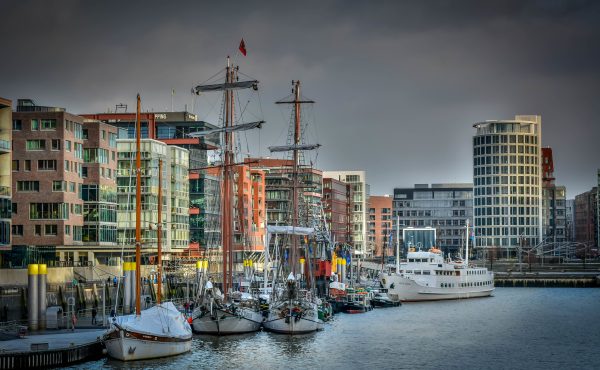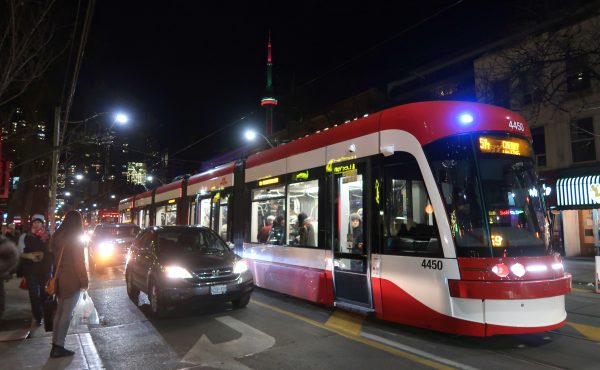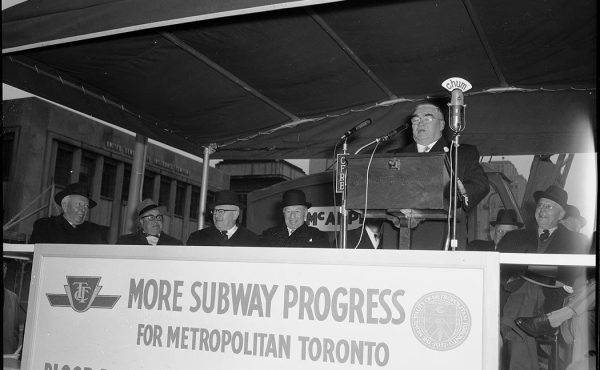
Could there be a more telling detail about the Ford administration’s pathologically perverse position on transit than the revelation, in Friday’s Globe and Mail, that Waterfront Toronto has started building a streetcar spur meant to serve the West Donlands on the q-t?
As my colleague Adrian Morrow noted in a tweet, Mayor Rob Ford refused to comment on the project, which appears to have been assigned a top-secret classification in case Mr. Subway Subway Subway emerges from his bunker to inveigh about the imminent “St. Clairization” (sic) of the waterfront.
However, Ford, though increasingly reclusive, didn’t hesitate to drop by a photo-op to demonstrate that the City’s works department is hard at work, trying to stop the Gardiner’s nether regions from flaking off like chunks of canned tuna.
But tout an almost absurdly modest improvement to the city’s downtown/waterfront streetcar service? Not going there.
Literally.
So allow me: a mayor who can see past the end of his nose would say something like this:
“These few metres of the Cherry Street line represent what I hope will be just the first leg of a fully integrated surface transit network meant to service the tens of thousands of people we expect to move into the new communities now being built in the East Bayfront, the West Donlands and, soon, the Portlands itself.
“This part of the city represents its future and the tracks to be laid on this street provide yet another example of how the City, Waterfront Toronto and the other orders of government are engaged in the collaborative work of city-building. While the line won’t go into service before the 2015 PanAm Games, the future residents of the West Donlands will find their new homes connected to Toronto’s transit network.
“Finally, we’re committed to these improvements because the developers who are creating these vibrant new waterfront communities have chosen to invest in the area on the explicit understanding that we will provide quality transit service. This project shows the City is listening closely to its private sector partners.”
Of course, it’s tough to articulate such sentiments if you happen to be wearing the icky face, or, as is more likely, are still fantasizing about a Jetson-style monorail choo-choo for the Portlands.
In any event, the mayor’s unwillingness to line up public support for the waterfront lines merely underscores an even more serious failing on the transit file, which is his infuriating absence from a positive discussion about the downtown relief line (DRL) at precisely the moment when Metrolinx and Queen’s Park are gearing up to make the case for more revenue sources for transit infrastructure.
Anyone with even a cursory understanding of the city’s transportation problems knows that the DRL is, or should be, Toronto’s single most important infrastructure investment in the next half century. The peak-period crowding at Union Station and at the Yonge-Bloor interchanges has become increasingly untenable, and even the Union subway platform expansion will be over-capacity within a few decades.
The question lurking around the edges of the DRL debate is this: what happens to the office sector in the downtown core — and all those thousands of well-paying jobs — if the subway system can no longer accommodate peak-period demand? This is not an impossibly remote problem. And yet the city and the region continue to make transit investments that pour traffic onto the Yonge-University-Spadina line. Metrolinx, while acknowledging the need to relieve crowding at Union Station within the next two decades, also wants to someday extend the Yonge line up into York Region. Does that happen before or after the DRL?
The DRL, in some ways, is like Toronto’s version of Manhattan’s Second Avenue subway, as veteran transportation planner Ed Levy demonstrates [ pdf, 4.3 MB ] – a tough, expensive but nonetheless essential project that has been perennially on the horizon for generations.
The Second Avenue Subway, however, is now under construction. As for the DRL saga, it reminds me of the fable about the frog in hot water. You keep raising the temperature bit by bit until it’s too late and the frog explodes. As Levy writes, “Track and platform capacity [at Union Station] is, it must be said, finite and could not accommodate long term growth in the absence of massively costly and disruptive reconstruction involving a second track and platform level.”
Metrolinx last fall began considering a pair of options [ pdf ]: first, an additional tunnels for the GO trains to accommodate the very high volume rail traffic that may run through the Union Station post electrification; and second, a variation on the DRL concept known as “Option 4B.” It combines a subway running between Pape and Queen stations along Queen East, but then ducks south from Queen West and terminates at a new GO/TTC/Air Rail Link interchange near Bathurst and Front.
To build a truly regional network that relieves crowding in the core, Levy argues compellingly [ pdf, text-only version ] that Metrolinx should pursue Option 4B and also oversee the transformation of the ARL into an ordinary (as opposed to premium) transit service. And, he says, it’s less important for the proposed DRL line to slavishly follow Queen Street than it is to create efficient inter-connections to the GO/ARL system.
It’s all well and good that experts like Ed Levy and Metrolinx’s planners are actively mulling over these (and other) scenarios. But they will never be more than scenarios unless our political leaders build a broad-based consensus in favour of funding the DRL as a critical piece of infrastructure for the entire GTA.
Yet we live in a weird time when the transit advocates on city council feel they must re-brand the DRL so it won’t be vulnerable to the sorts of AM radio/culture-war attacks that greeted the LRT lines. Meanwhile, the region’s single most visible municipal leader, Rob Ford, can’t bring himself to tout the construction of a few hundred metres of streetcar track, has an aversion to new funding tools for transit, and seems disinclined to try to figure out why the DRL will provide relief to the very suburban commuters whose interests he professes to defend.
Having arrived at a bone fide fork in the road, our incurious chief magistrate is fixated on the rubble lying on the pavement, but seems tragically incapable of reading the map.






17 comments
As far I can tell, the decisions to fund and build the Cherry St line were made when Ford was still a councillor and were adopted on consent (i.e., no objections). Ford either agreed to it at the time or was not there for the vote – either way, he would make himself look stupid by objecting at this point. It also ties in with his newly discovered faith in the Pan Am Games.
Why fight people in the west end and waste money now when you could just open a non-premium electrified service from day one? Or shortly after. The money saved could go to other worthy transit projects. Fight to the death saying the ARL is not for local traffic or as much airport traffic as it could handle, then come up with 4B and go 100% the other way. Sometimes one is left scratching their head.
Perfect summation of the current state of transit development in the city.
Great piece.
The original Queen subway (which would have first used the PCC streetcars at the time) was to be constructed after the original Yonge Subway (heavy rail). Instead, it was decided to move the project up to Bloor and Danforth, away from the financial district and to use heavy rail. To allow passengers access to the financial district, the University Subway was constructed.
The University and Spadina lines does take some congestion off the Yonge line, but mostly from the west. Passengers from the east and north mostly use the Yonge line. Once the Spadina line is extended up into Vaughan, it should draw passengers from the north. However, it will only delay. A downtown relief line that serves the financial district is still needed, sooner and not later.
Can anyone else read the report linked at https://spacing.ca/toronto/wp-content/uploads/2012/05/Pages-from-A-Case-for-the-Downtown-Rapid-Transit-Relief-Line-and-a-Union-Pearson-Rapid-Transit-Service-April-2012.pdf?
In my pdf reader, it comes out as backwards (characters printed right to left). It looks like it was scanned with the sheets reflected.
I’ve downloaded it and it reads fine. It is a scanned document but no other problem.
DRL is the last thing we need. LRT only advocates have won me over. I am now a rigid ideologue and I HATE SUBWAYS!!!
Build LRT’s only and use the existing rail corridors for above ground paths.
Then force Presto on the entire system so that if you want to take a Go to Oriole from Union then you get a free transfer to the Sheppard LRT and make it all one fare zone.
The offhand part at the end, which notes that integrating the GO system with the TTC and increasing headways would avoid parallel lines, is the most important part. There is a three-part solution out there — high frequencies, physical integration with interchanges, and platform-neutral fare by distance — that is still waiting to happen. It simply cannot be nearly as expensive to leverage the rights of way that are in place, as to dig new tunnels or expropriate new corridors. This is by far the biggest bang-for-the-buck thing that could be done to revolutionize transit in Toronto, and yet it is the least discussed. Why?
The ARL was never meant for local service. It has been meant for an express service from Airport to downtown. Weston is not downtown or the airport.
While the DRL is a definite must in the long run, a good short term solution is to connect Sheppard to Downsview. Those coming from the West would have the option of taking the Spadina/University line into the city.
It’s not ideal, but it can take a little pressure off the Yonge line.
A downtown relief line needs to be a fully connect line from Dundas West via downtown to Pape. It can either be a subway or LRT. It should not be a GO train in the west and some modified streetcar line in the east.
People in Toronto need to realize that most jobs in the Toronto area are not in the downtown core and many jobs are not even in Toronto city limits anymore, and there are massive traffic congestion problems in the suburbs. There are hundreds of thousands of jobs in suburban areas such as Mississauga (mostly near the airport), Markham (near the 404/407 interchange), Vaughan, Brampton, Oakville, North York, Scarborough etc. and transit is severely inadequate in those areas. In particular, Highway 401 is notoriously congested despite having up to 18 lanes in some sections, and primarily used by suburb to suburb commuters, particularly people who work in the Pearson Airport area of Mississauga. Similarly the Don Valley Parkway is congested all day 7 days a week north of the DVP/Don Mills interchange, and it is largely used by suburb to suburb commuters as the section close to downtown is much less congested. While the overcrowding problems on the Yonge subway line are severe, the fastest and cheapest way to deal with these problems is to massively boost frequencies on GO Transit rail corridors which go downtown such as the Lakeshore line. However, since the worst traffic is in the suburbs, a large amount of funding is needed to improve suburb to suburb transit infrastructure. 3 light rail lines in the suburbs is not remotely adequate.
Front St. transit anyone? A transitway?
I think it’s been obvious for about a decade, and funnily enough, a few years in to the anti-Front St. Extension fight with many NDP etc., there was some offical study backing of it as being sensible in the WWLRT.
While to some extent the route is being squandered and buggered with, it might still be possible and it has potential for being up and running faster than a full subway.
I imagine some of my less-welcome comments years back on this site might have made mention of relieving pressure on Union Station etc.
And it remains a squandering of potential what is underway on the rail-line to the northwest – it needed far better connectivity and a different technology to be suited for the greenhouse century, including a recognition that air travel is really bad for the climate and needs to be phased out if we value survival.
Andrew, the fixes to congestion in the suburbs will require more than just a bit of transit funding. Their fundamental blueprint is wrong, and it will require many changes to make them more amenable to non-drivers: mixed-use zoning, rationalizing the grid, pedestrian and cycling paths. Since all of those changes will be retrofits, they’ll be quite expensive, but without them no amount of transit infrastructure will fix the 401.
Meanwhile, the DVP is not congested 24/7. I drive it all the time and it has very clear peak periods outside of which it’s a pleasant and fast drive.
That said, improved GO is certainly an important step towards improving commutes across the GTA.
Murphysg, the Sheppard-Finch LRT Benefits Case discusses the value of connecting Downsview to Sheppard by subway and ultimately concludes that it’s not a cost-effective solution, favouring instead connecting the Finch and Sheppard LRTs via Don Mills.
In the suburbs we are stuck with a lot of poor planning and we have to make do with what we have. Jobs move to office parks near the airport and 407/404 interchange because the rent is much cheaper than downtown Toroto. Nevertheless there are many improvements that can be made to fix transit in the suburbs. These include two way all day GO on all lines which allows commuting between suburbs and from Toronto to the suburbs; more subway lines in the suburbs; boosting bus frequencies on major suburban bus routes; and the Hurontario light rail line in Peel Region. There is an illusion that most people work downtown, when in fact the downtown core only has about 400,000 jobs and is small by big city downtown standards. There is also an illusion that Toronto’s suburbs are low density, which many are not because the majority of the population of Toronto proper and a growing fraction in the 905 lives in apartment buildings. Much as the downtown relief line and/or more GO trains downtown is needed to get people off the overcrowded Yonge line, which I have taken many times, downtown is far from the only area that needs better transit.
DRL will never get built as long as you keep calling it the Downtown Relief Line. Might as well call it the Pinko Frappuccino Line. IMO, calling the DRL the Her Majesty’s Royal Harper Majority Government Job Creation Line is our best chance of getting it built.